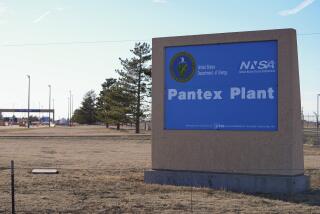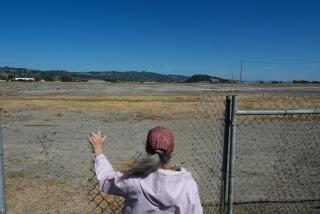They’ve waited years for cleanup in Alaska
anchorage, alaska -- For countless generations, Yup’ik Eskimos fished the Suqitughneq River on St. Lawrence Island. Though his grandfather once pulled salmon and trout from its waters, George Noongwook has never done so.
The Yup’ik whaling captain from the village of Savoonga is wary of lingering diesel and PCBs from a deserted Cold War surveillance site nearby. He believes they will make him sick.
“There hasn’t been anyone fishing there in my lifetime because all the fish died,” said Noongwook, 58. “They’re back now, but everyone knows [the river] is contaminated so they go elsewhere.”
The old Air Force base at Northeast Cape, 140 miles from the Russian mainland, is one of at least 640 contaminated military installations across Alaska dating from World War II and the Cold War. In all, they will cost at least $1 billion to clean up, according to the U.S. Army Corps of Engineers.
Many of these decaying or downsized outposts are sullying lands and waterways used as primary food sources by at least two dozen tiny communities. Thousands of rural Alaskans subsist on wild plants and animals such as caribou, salmon and berries.
Old barracks and radar stations from the Arctic coast to the Aleutian Islands contain now-banned materials such as asbestos and lead paint, according to state environmental records. Hidden landfills harbor unknown quantities of scrap metal and munitions. Diesel, PCBs, pesticides and heavy metals have seeped unchecked into soils and rivers.
Conflicting studies on any lingering health hazards worry many rural residents, who blame the sites for recent increases in cancer and other diseases.
A study in 2002 showed that islanders who hunt and fish near Northeast Cape have nearly 10 times as many PCBs in their blood as average Americans, but more research needs to be done, said Dr. David Carpenter, an environmental health professor at the University of Albany in New York who led the study.
In the meantime, residents of these isolated villages wait with varying degrees of patience as the years-long cleanups run their course.
At Cape Lisburne on the Chukchi Sea, a scaled-down Cold War radar site continues to leak contaminants onto prime hunting grounds inhabited by caribou, grizzlies and walrus, said Earl Kingik of Point Hope. Pollution from the site runs directly into the Chukchi, part of the Alaska National Maritime Wildlife Refuge, according to the state’s contaminated sites database.
“There was a cleanup several years ago, but we are not satisfied,” said Kingik, co-chairman of a community group that advises the military on cleanup. “The landfill is right on the drainage into the ocean.”
The military receives congressional funding for cleanups nationwide through the Department of Defense’s Environmental Restoration Program, started in 1987.
In 2007 the U.S. Army Corps of Engineers received $262.8 million for the cleanup of 9,000 former defense sites nationwide. Nearly 8% of that went to Alaska.
The state contains the third-highest number of formerly used defense sites in the nation, behind California and Florida, according to the corps, which is in charge of 600 sites in Alaska.
“The military has changed, technology has changed, the threat has changed. The decision to scale down is a combination of all kinds of things,” said Tommie Baker of the 611th Civil Engineer Squadron. The 611th is responsible for environmental restoration of about 40 Air Force sites in Alaska.
During World War II, Alaska became a transit hub for weapons and supplies sent to Russia under the Lend-Lease program. In 1942, the Japanese capture of Attu and Kiska in the Aleutian Islands also spurred military buildup.
Radar and satellite stations sprang up along the northern and western coasts during the Cold War to watch for Soviet air attacks launched over the North Pole.
The military said it had been steadily clearing away the most conspicuous remnants of war, including barracks, radio towers, construction equipment and mounds of rusted oil drums.
“At Northeast Cape we have gotten rid of buildings and other visible impacts,” said Carey Cossaboom, a project manager with the Army Corps of Engineers. “We’re now moving to the leftover contamination in the ground, the nonvisible impacts, which are very real.”
Of 1,500 contaminated sites within the 640 installations, about 50% have reached sufficiently clean standards, according to Alaska’s Department of Environmental Conservation. The agency oversees the cleanups and determines when they can stop, based on state regulations.
“They’re required to clean to levels that are not considered an unacceptable risk,” said John Halverson, an environmental program manager at the department. “It’s not feasible to clean anything up to original background levels, but that means sometimes the landowners won’t be happy.”
A former Army installation at Moses Point, an important Inupiat Eskimo fishing site in western Alaska, was closed two years ago to further cleanup. Paul Nagaruk, former mayor of the nearby village of Elim, said the project was far from successful.
The village of 300 people has requested Alaska Community Action on Toxics to do additional testing and studies. The organization advocates for environmental health in communities.
“Our people welcomed the military, our men enlisted, they helped rescue downed planes and the Department of Defense has not taken into consideration the human health effects of these places,” said Vi Waghiyi, coordinator of the environmental health and justice program for the nonprofit’s Norton Sound Alaska Project. “The Army Corps has not properly identified what is left and a lot of times the burden of proof is on communities.”
State and federal officials say funding for cleanup on deserted military installations in the state is dwindling and the projects take years to research and execute.
The $20 million allotted to the Army Corps of Engineers for Alaska this year represents a steady annual decrease since 1998, when the Corps received $50 million.
Sites in Alaska generally cost more to clean up than in other states because of the logistics of traveling across vast stretches of roadless terrain and the short summer work season.
“You can only go by barge to Northeast Cape and you need to get in by mid-June and get out by September or risk being stuck all winter,” said Kenneth Andraschko, the corps’ acting program manager for former defense sites in Alaska. “You’re at the whim of Mother Nature.”
St. Lawrence Island residents hope that one of these summers, the remnants of a 30-year-old, 180,000-gallon diesel spill will be removed from the Suqitughneq River. Then, just maybe, they will return to its banks to fish.
“You can smell it and you can see it,” Noongwook said of the diesel. “Before the military came, the river was an important subsistence source, a great ecosystem.”
More to Read
Sign up for Essential California
The most important California stories and recommendations in your inbox every morning.
You may occasionally receive promotional content from the Los Angeles Times.










